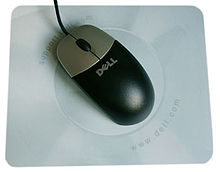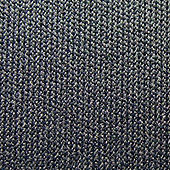Mouse pad
A mouse pad , also known as a mousepad , in Switzerland also known as a mouse mat , is a special underlay that is intended to improve working with a computer mouse .
history
The idea for the mouse pad comes from Douglas Engelbart , who first put it on display during his historical presentation “The mother of all demos”. The presentation became famous above all through the first display of a computer mouse, where he used a small area as a mouse pad .
From 1982, the majority of mouse users are said to have used a touchpad, both of which were mostly produced by the Xerox company .
advantages
With the invention of the mouse pad, there were three decisive advantages:
- higher speed when operating the PC
- higher precision
- higher comfort
A mouse pad also protects the table surface from scratches and other signs of wear, such as the worn material of the rubber ball.
variants
Textile pads
For a long time, a type of mouse with an integrated ball which scanned the surface was predominant. However, since many surfaces did not offer optimal adhesion for the balls, special pads were developed that allowed the mouse housing to slide over it without any problems, but prevented the ball from sliding instead of rolling. The latter is necessary so that the signal rollers of the mouse can be moved.
Textile pads have a textile surface that is glued onto a thin layer of foam. The foam primarily ensures that the pad does not slip, and secondly that the hand lies softly.
Modern mouse pads
The "modern" mouse pad is made from a wide variety of materials. The most common are pads made of plastic, fabric, glass or metal. A combination of different materials is also possible. These pads usually have rounded edges, are ergonomic and as flat as possible. Some ergonomic mouse pads have a flexible raised palm rest. This support is intended to prevent unnatural kinking of the hand when using the mouse and thereby avoid complaints such as repetitive strain injury syndrome . The gel cushions can differ in their strength.
Today, the surface structure of the pad is particularly crucial, as mice with optical scanning have replaced those with roller balls.
Computer gamers prepare their mouse pads, with the exception of cloth pads, sometimes with silicone spray in order to be able to make movements with the mouse as precisely as possible. An alternative to improving the properties of a mouse pad is to use Teflon pads, which are subsequently glued to the underside of the mouse. Both methods, which can also be used simultaneously, reduce friction.
An elastic thickening in an ergonomically designed mouse pad enables the hand to be placed in the area of the wrist without kinking it. This greatly reduces the stress when working with the mouse.
Gaming mouse pads
In professional electronic sports, the mouse pad is of great importance, as it has a strong influence on the clarity of the physical movements of e-athletes when playing. The surfaces, some of which have been specially developed for sport, allow the mouse to glide over the pad and thus have a positive influence on the user's gaming behavior. Nowadays companies are even joining forces with professional teams from esports to jointly develop high-quality pads.
In the gaming scene, mouse pads are often divided into low sense ( a large mouse pad for low sensitivity settings of the mouse) and high sense (high sensitivity, small mouse pad).
Sliding properties
Depending on the nature and material, the mouse pads are assigned different sliding properties, which can be extremely relevant for the optimal use of the user.
Mouse pads for ball mice
In the case of ball mice, it is important to ensure a good balance between the gliding ability and the resistance of the pad, as ball mice on the one hand need a certain gliding ability so that the ball rolls, and on the other hand there must be a certain resistance so that the ball does not slip and block. Most users therefore use a pad with a textile surface.
Mouse pads for optical mice
Optical mice work on the basis of contrasts, which is why single-color mouse pads can lead to disruptions in use. This is usually counteracted with patterned textile pads or rough, hard pads.
Web links
Individual evidence
- ↑ mouse mat. In: PONS online dictionary. Retrieved November 5, 2018 .
- ↑ Detlef Borchers: 40 years ago: the mouse tore and gave birth to a new world. In: heise online. September 12, 2008, accessed November 16, 2014 .
- ^ Designing and Testing the Optical Mouse. Retrieved November 17, 2014 .



